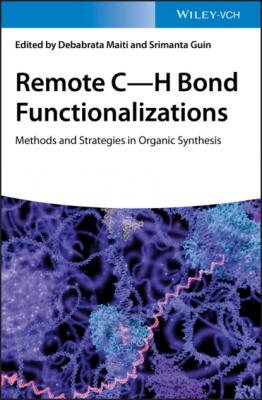Remote C-H Bond Functionalizations. Группа авторов
Читать онлайн.| Название | Remote C-H Bond Functionalizations |
|---|---|
| Автор произведения | Группа авторов |
| Жанр | Химия |
| Серия | |
| Издательство | Химия |
| Год выпуска | 0 |
| isbn | 9783527824144 |
Scheme 2.4 meta‐C–H olefination of hydrocinnamic acid derivatives.
In 2016, Maiti and coworkers disclosed a 2‐hydroxybenzonitrile template for mono meta‐selective olefination of hydrocinnamic acids via an ester linkage (Scheme 2.5a) [14]. Due to the less statistical availability of the coordinating nitrile group compared with the original 2,2′‐azanediyldibenzonitrile directing template, high mono‐/di‐selectivity could be obtained with this new template at lower reaction temperature using 1,2‐dichloroethane (DCE) as the major solvent and HFIP as the minor solvent. Notably, hetero‐di‐olefination product could be afforded with a second meta‐C–H olefination under similar reaction conditions using HFIP as the sole solvent (Scheme 2.5b).
Scheme 2.5 (a) 2‐hydroxybenzonitrile template assisted mono meta‐selective olefination of hydrocinnamic acids; (b) meta‐selective hetero‐di‐olefination of hydrocinnamic acids.
Source: (a) Modified from Modak et al. [14].
Most recently, Li and coworkers developed the first example of carboxy group assisted, remote meta‐selective C(sp2)–H activation with a PdII‐catalyst via potential κ2 coordination of the carboxyl, suppressing the ortho‐C–H activation via the κ1 coordination (Scheme 2.6a) [15]. Unlike the previous nitrogen‐based CN‐containing or heteroarene‐containing templates, this is the first oxygen‐based carboxyl‐containing template, whose coordination geometry could be considered as a pseudo‐linear coordination along the aryl–CO2M bond similar to the nitrile‐coordination geometry. Notably, hydrocinnamic acids could be meta‐olefinated in a remote selective fashion, leaving the C
Scheme 2.6 (a) Proposed remote‐selective C‐H activation via κ2 coordination of the carboxyl. (b) Remote‐selective meta‐C–H olefination of hydrocinnamic acids. (c) Improved site‐selectivity and reactivity with a modified carboxyl‐containing template.
Source: (a) Modified from Li et al. [15].
Besides Pd‐catalysts, Rh‐catalyst could also be used for olefination of hydrocinnamic acids. In 2017, Lu, Sun, Yu, and coworkers reported the first example of Rh(III)‐catalyzed, directing template assisted remote meta‐C–H olefination of hydrocinnamic acids via a postulated 12‐membered macrocyclic intermediate (Scheme 2.7a) [16]. The directing template bearing a single nitrile group was slightly different from Yu's seminal template. Moreover, molecular oxygen could be used as the terminal oxidant for this reaction. Subsequently, meta‐C–H alkenylation of hydrocinnamic acids was also realized using alkynes, which are significantly less reactive than the polarized and reactive acrylate (Scheme 2.7b) [17]. Notably, transition metal‐catalyzed meta‐alkenylation using alkynes has not been successful with Pd catalysts in previous reports on the directing template strategy.
Scheme 2.7 (a) Rh(III)‐catalyzed directing template assisted remote meta‐C–H olefination of hydrocinnamic acids. (b) Rh(III)‐catalyzed meta‐C–H alkenylation of hydrocinnamic acids using alkynes.
Source: (a) Modified from Xu et al. [16]; (b) Modified from Xu et al. [17].
In addition to meta‐C–H olefination, meta‐C–H arylation of hydrocinnamic acids was made possible using the directing template strategy. In 2013, Yu and coworkers reported the first example of Pd‐catalyzed cross‐coupling of meta‐C
